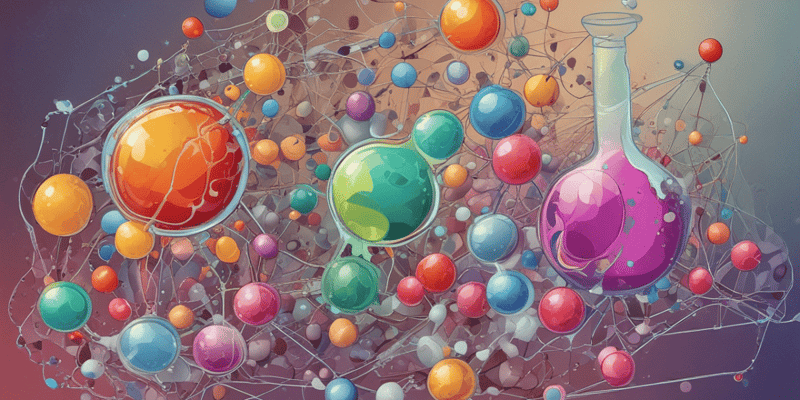Questions and Answers
What is the characteristic of a homogeneous mixture?
Uniform composition throughout.
Which method is used to separate a solid from a liquid or a gas?
Filtration
What is a characteristic of a pure substance?
Fixed melting and boiling points.
Which method is used to separate liquids based on differences in boiling points?
Signup and view all the answers
What is a characteristic of a heterogeneous mixture?
Signup and view all the answers
Which method is used to separate and identify components of a mixture based on their interactions with a stationary phase?
Signup and view all the answers
What is the purpose of centrifugation?
Signup and view all the answers
What is a method used to identify a heterogeneous mixture?
Signup and view all the answers
Study Notes
Types of Mixtures
-
Homogeneous Mixtures: Uniform composition throughout, also known as solutions.
- Examples: air, saltwater, blood
-
Heterogeneous Mixtures: Non-uniform composition, components can be visibly distinguished.
- Examples: sand and water, oil and water, trail mix
Identifying Heterogeneous Mixtures
- Visual Inspection: Components can be seen separately.
- Settling: Components settle at different rates due to differences in density.
- Filtration: Components can be separated using a filter.
- Magnetic Separation: One component is attracted to a magnet, while the other is not.
Characteristics of Pure Substances
- Fixed Melting and Boiling Points: Pure substances have a specific melting and boiling point.
- Constant Composition: Pure substances have a consistent composition throughout.
- Cannot be Separated: Pure substances cannot be separated into simpler components by physical means.
Separation Techniques
- Filtration: Used to separate a solid from a liquid or a gas.
- Crystallization: Used to separate a solid from a solution.
- Distillation: Used to separate liquids based on differences in boiling points.
- Chromatography: Used to separate and identify components of a mixture based on their interactions with a stationary phase.
- Centrifugation: Used to separate particles of different densities or sizes.
Types of Mixtures
- Mixtures can be classified as either homogeneous or heterogeneous, based on their composition.
- Homogeneous Mixtures: Have a uniform composition throughout, meaning they have the same proportion of components throughout the mixture, e.g., air, saltwater, and blood.
- Heterogeneous Mixtures: Have a non-uniform composition, meaning their components can be visibly distinguished, e.g., sand and water, oil and water, and trail mix.
Identifying Heterogeneous Mixtures
- There are several ways to identify heterogeneous mixtures, including:
- Visual Inspection: Components can be seen separately, making it easy to identify them.
- Settling: Components settle at different rates due to differences in density.
- Filtration: Components can be separated using a filter, allowing for their identification.
- Magnetic Separation: One component is attracted to a magnet, while the other is not, making it possible to identify them.
Characteristics of Pure Substances
- Fixed Melting and Boiling Points: Pure substances have a specific melting and boiling point, which remains constant.
- Constant Composition: Pure substances have a consistent composition throughout, meaning their components are always present in the same proportion.
- Cannot be Separated: Pure substances cannot be separated into simpler components by physical means, meaning they are fundamentally pure.
Separation Techniques
- There are several techniques used to separate mixtures, including:
- Filtration: Used to separate a solid from a liquid or a gas, by passing the mixture through a filter.
- Crystallization: Used to separate a solid from a solution, by cooling the solution slowly to allow crystals to form.
- Distillation: Used to separate liquids based on differences in their boiling points, by heating the liquids and collecting the vapors.
- Chromatography: Used to separate and identify components of a mixture based on their interactions with a stationary phase, such as a solid or liquid.
- Centrifugation: Used to separate particles of different densities or sizes, by spinning the mixture at high speeds.
Studying That Suits You
Use AI to generate personalized quizzes and flashcards to suit your learning preferences.
Description
Identify and understand the differences between homogeneous and heterogeneous mixtures, including visual inspection, settling, and filtration methods.




